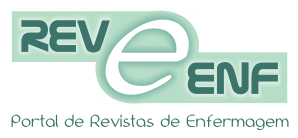Actions implemented in the preparation and endovenous administration of heparin: adverse event report
adverse event report
Abstract
Objective: to report an adverse event in the preparation and endovenous administration of heparin and actions implemented by the health team. Methods: this is an experience report on the actions implemented after analyzing an adverse event in the preparation and administration of heparin in a patient admitted to a University Hospital in southern Brazil. Data were collected from the patient’s medical records, minutes of meetings of the teams involved, and the action plan of the measures instituted after an event that occurred in November 2017. Results were analyzed in a descriptive manner and the project was approved by the Research Ethics Committee. Results: the actions carried out included the review of routines and protocols related to the calculation of dose, preparation, and endovenous administration of heparin. There was inclusion as a high-alert medication and double checking. Institutional-level guidelines and alerts were also released to all members of the nursing team. Conclusion: the experience contributed to highlight the need to monitor incidents and their impacts, find strategies to reduce them through process reviews and implementation of actions in care practice aiming at greater safety in the preparation and endovenous administration of heparin.
Downloads
References
GöttemsLBD, Santos MLG, Carvalho PA, Amorim FF. A study of cases reported as incidents in a public hospital from 2011 to 2014. Rev Esc Enferm USP. 2016; 50(5):861-867. DOI: https://doi.org/10.1590/s0080-623420160000600021.
Roque KE, Tonini T, Melo ECP. Adverse events in the intensive care unit: impact on mortality and length of stay in a prospective study. Cad Saúde Pública. 2016; 32(10):e00081815. DOI: http://dx.doi.org/10.1590/0102-311X00081815.
Oliveira AC, Garcia PC, Nogueira LS.Nursing workload and occurrence of adverse events in intensive care: a systematic review. RevEscEnferm USP.2016;50(4):679-689. DOI:
https://doi.org/10.1590/S0080-623420160000500020.
Lopes SS, Batista KM, Bringuente MEO, Luciano LS.Consecutive 24-hour working day and implication for the office of nursing. CiencCuid Saúde. 2018;17(3): e37244. DOI: https://doi.org/10.4025/cienccuidsaude.v17i3.37244.
Pirinen H, Kauhanen L, Danielsson-Ojala R, Lilius J, Tuominen I, Rodríguez ND, et al. Registered Nurses’ Experiences with the Medication Administration Process. AdvNurs. 2015; 941589. DOI: https://doi.org/10.1155/2015/941589.
Paranaguá TTB, Bezerra ALQ, Santos ALM, Silva AEBC. Prevalence and factors associated with incidents related to medication in surgical patients. Rev Esc Enferm USP. 2014; 48(1): 41-47. DOI:https://doi.org/10.1590/S0080-623420140000100005.
World Health Organization. Medication without harm – WHO Global Patient Safety Challenge. Geneva: World Health Organization. [Internet] 2017. [cited on 2020 Jan 21]. Available from: https://apps.who.int/iris/bitstream/handle/10665/255263/WHO-HIS-SDS-2017.6-eng.pdf?sequence=1
Wondmieneh A, Alemu W, Tadele N. Medication administration errors and contributing factors among nurses: a cross sectional study in tertiary hospitals, Addis Ababa, Ethiopia. BMC Nurs. 2020;19(4):1-9. DOI: https://doi.org/10.1186/s12912-020-0397-0.
Riley M, Meyers R, Advocacy Committee for the Pediatric Pharmacy Advocacy Group. Position Statement on Heparin Safety Concerns. J PediatrPharmacolTher. 2016; 21(6): 530-532. DOI: https://doi.org/10.5863/1551-6776-21.6.530.
Pino FA, Weidemann DK, Schroeder LL, Pabst DB, Kennedy AR. Failure mode and effects analysis to reduce risk of heparin use. Am J Health-Syst Pharm. 2019; 76(23): 1972-1979. DOI: https://doi.org/10.1093/ajhp/zxz229.
Brasil.Ministério da Saúde. Conselho Nacional de Saúde. Resolução no510, de 7 abril de 2016. Trata sobre as diretrizes e normas regulamentadoras de pesquisas envolvendo seres humanos. Brasília: 2016. [Internet]. [citado em 19 jan 2020] Disponível em: http://conselho.saude.gov.br/resolucoes/2016/Reso510.pdf
Canadian Safety Institute. Canadian Disclosure Guidelines:Being with patients and families. Ottawa:2011. [Internet]. [cited on 2021 Jan 27].Available from: https://www.patientsafetyinstitute.ca/en/toolsresources/disclosure
Bezerra TB, Valim MD, Santos EC, Lima JDA, Ribeiro AC.Perception of the nursing team on climate organizational safety of a public hospital. Enfermglob. 2019;53:103-118.DOI: https://doi.org/10.6018/eglobal.18.1.309061.
Irajpour A, Farzi S, Saghaei M, Ravaghi H. Effect of interprofessional education of medication safety program on the medication error of physicians and nurses in the intensive care units. J Educ Health Promot. 2019;24(8):196. DOI: 10.4103/jehp.jehp_200_19.
Härkänen M, Paananen J, Murrells T, Rafferty AM, Franklin BD. Identifying risks areas related to medication administrations - text mining analysis using free-text descriptions of incident reports. BMC Health Serv Res. 2019; 19:791. DOI:https://doi.org/10.1186/s12913-019-4597-9.
Valle MMF, Cruz EDA, Santos T. Medication incidents in an outpatient emergency service: documental analysis. RevEscEnferm USP. 2017; 51:e03271. DOI: https://doi.org/ 10.1590/s1980-220x2016033303271.
Kavanagh C. Medication governance: preventing errors and promoting patient safety. Br J Nurs. 2017;26(3):159-165. DOIhttps://doi.org/10.12968/bjon.2017.26.3.159.
Barbara S, Katarzyna W, Wolfgang S. Improving Patient Safety Through Human-Factor-based Risk Management. ProcediaComput Sci. 2015; 64:79-86. DOI: https://doi.org/10.1016/j.procs.2015.08.466.
Copyright (c) 2021 Ciência, Cuidado e Saúde

This work is licensed under a Creative Commons Attribution-NonCommercial 4.0 International License.





















